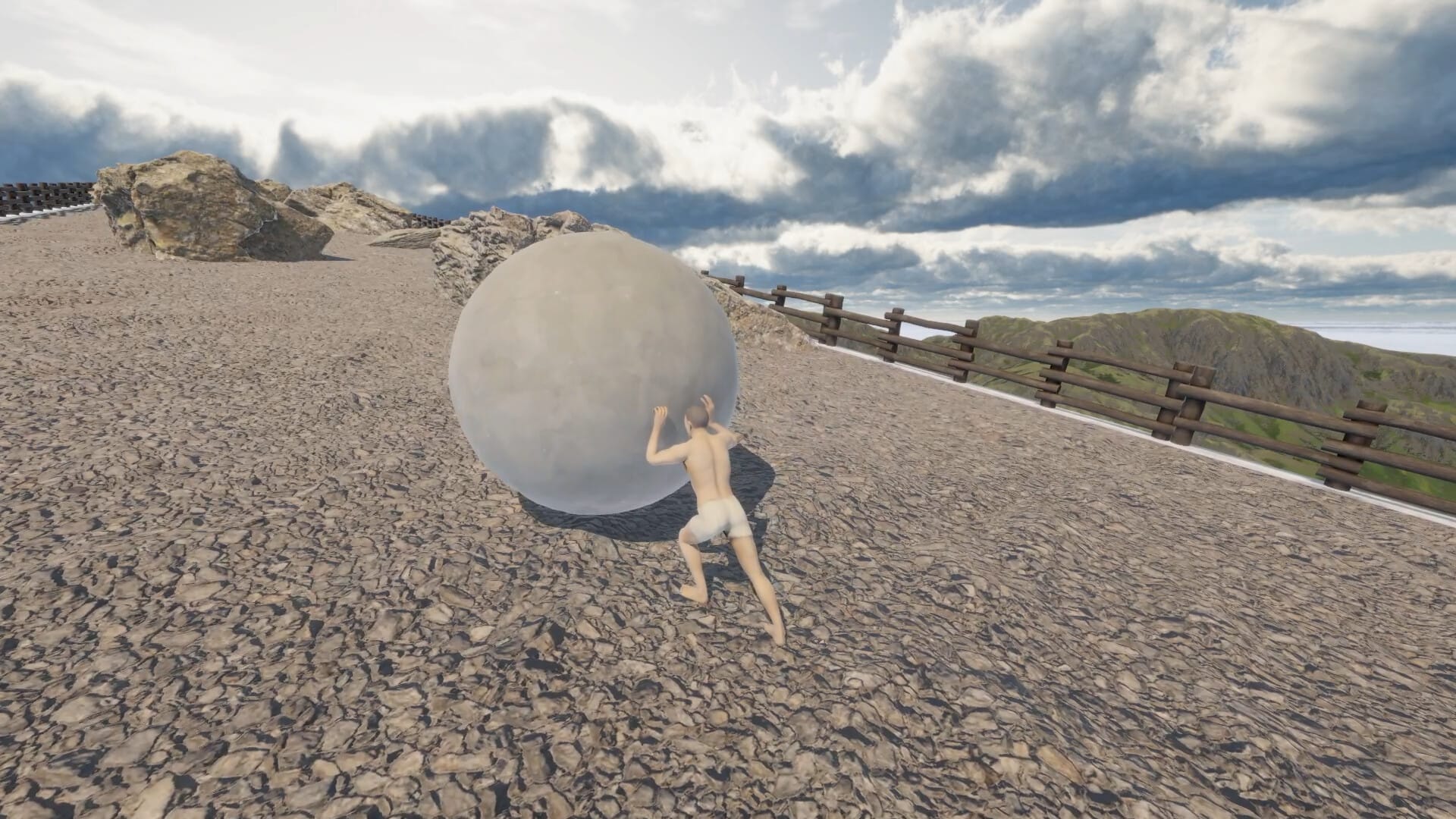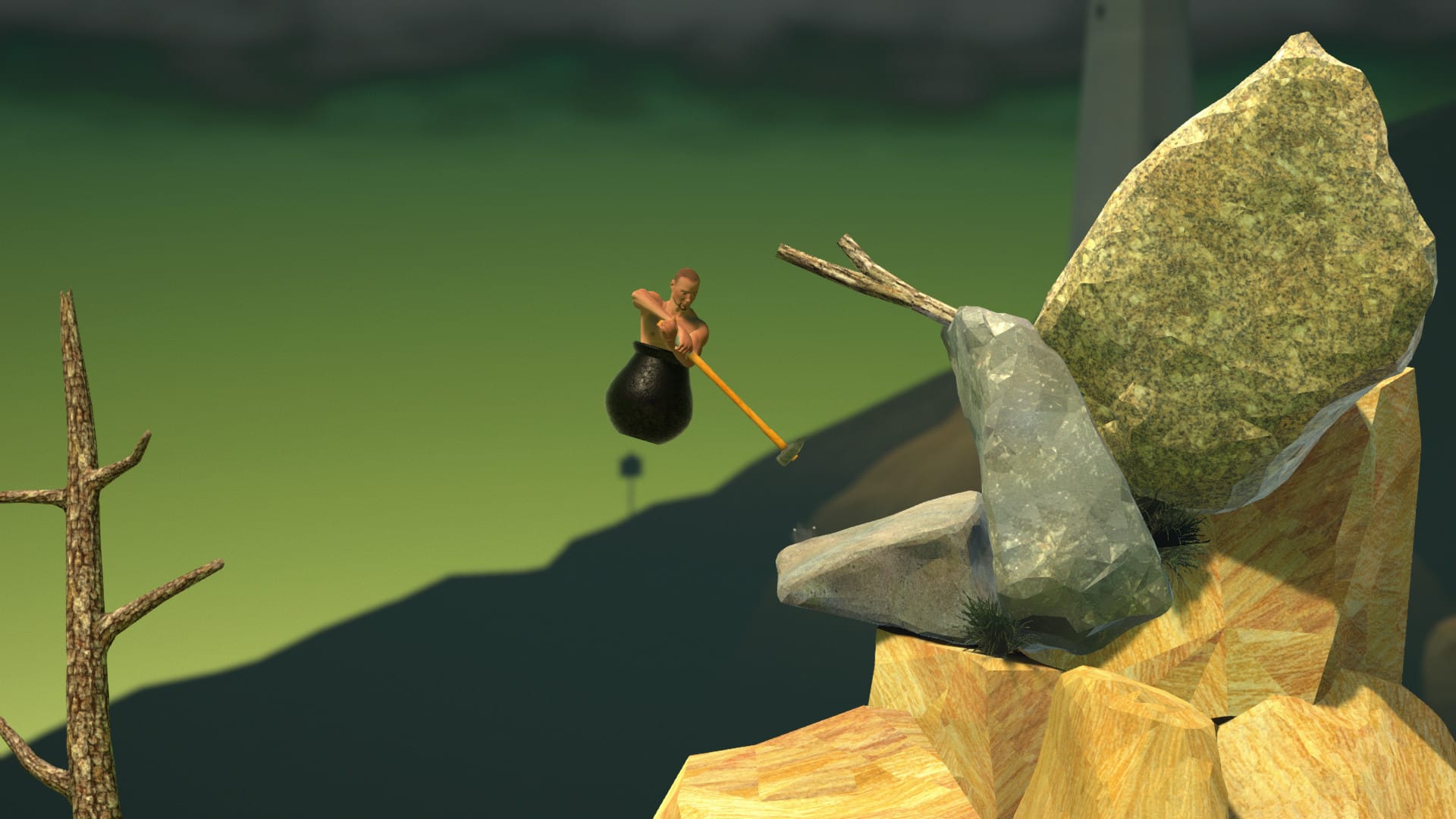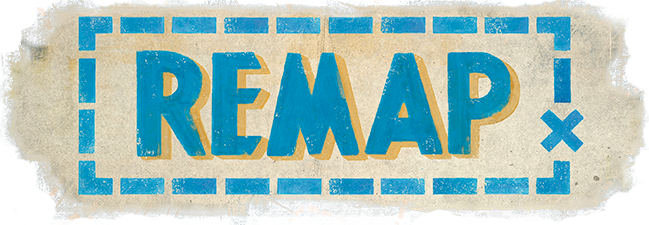The whole idea started as a joke.
I’d seen the hilarious clips of the streamer Northernlion playing a game where you rolled a boulder up a hill, and thought playing the same game would be a fun way to spend an hour during Remap’s in-person livestream. What I did not expect was to become emotionally and spiritually invested in rolling that same boulder up a hill, to the point that I’m confident in saying that playing The Game of Sisyphus was, all told, one of the most thrilling game experiences I’ve had in years.
While reflecting on my favorite games from the year 2021, I wrote that “all I asked from video games in 2021 was to make me feel something.” 2021 was a draining and frustrating year. That is not how I’d describe 2024, but the sentiment stand. As I’ve gotten older, often what I’m looking for from media, whether games or otherwise, is for those experiences to make me feel.
In The Game of Sisyphus, the premise is as simple as it is deceptive: slowly push a rock up a hill, inch by inch. The important catch, of course, is that the path to the top is filled with traps meant to dislodge the boulder from your hands, sending it back down to the bottom. It’s not a game with checkpoints, and often, it feels buggy and unpolished in ways that make you go “is it supposed to work that way?” But pushing the boulder feels good and satisfying, the tricks are fun and smart, and the sense of betrayal you feel, both personal and cosmic, when the boulder slips away, accelerating down the hill at a speed that’d make an F1 driver blush, is intoxicating.
When I’d made it to the top of the hill, I wanted to tear my clothes off and scream.
“We have been creating games that frustrate streamers for a long time,” said The Game of Sisyphus designer Yoo Jaejun in an email interview with me recently.

Jaejun is a designer at cream, who’s published a handful of games on Steam over the past few years also designed around irritation, including 2021’s Slow and Steady, where “the slowest tortoise ever” must work its way to an arbitrary finish line, filled with similar setbacks to The Game of Sisyphus. In 2022’s Into the Sinkhole, players are a robot tasked with going deeper and deeper, despite the world around you doing its best to keep you from going any further.
Both of these games sound, frankly, incredible.
“We love creating these games and watching the reactions of streamers and YouTubers,” said Jaejun, who said he was aware of Northernlion’s streams, which helped popularize the game. “We couldn't understand most of it, but Northernlion and his viewers' reactions were very entertaining.”
Frustration, it turns out, is a universal emotion.
(cream is a South Korean game developer, and the developers do not speak English. We spoke through a translator over email.)
“While it was intended for players to get frustrated watching the boulder roll, we also wanted them to feel a sense of unfairness,” said Jaejun. “We believe this emotion aligns with Albert Camus's sense of absurdity.”
Over two weeks, I suffered the joy and defeat of this boulder. You can watch my journey.
The Game of Sisyphus was directly influenced by French philosopher Albert Camus, noteworthy for many works, but in this instance, most importantly for writing 1942’s The Myth of Sisyphus, an exploration of the absurdity of life once one internalizes that it is, ultimately, meaningless.
“Man stands face to face with the irrational,” wrote Camus. “He feels within him his longing for happiness and for reason. The absurd is born of this confrontation between the human need and the unreasonable silence of the world.”
Video games are themselves irrational creations, yet completing their challenges is often a joy.
“This game is designed to induce rage but aims to make players moderately angry,” said Jaejun, who noted that in earlier versions of the game, the boulder rolled much faster than it does now.
[rubs temples]
It’s a strange game to parse, and in Jaejun’s telling, even stranger to develop. The game is split into levels, but unlike most games, completing a level does not ensure progress, it simply means you’re in the next section. If the ball rolls the right (or wrong) way, you can lose progress. It creates a fascinating sensation, as players can never be confident in their accomplishments.
“When we first started level design, we classified the sections into three types,” he said. “The first type is the most difficult section, the second type is easy but allows the boulder to roll down well, and the third type has a moderate difficulty and allows the boulder to stop appropriately.”
Over time, you can see what Jaejun means, as there are clearly levels where the boulder is likely—but not guaranteed—to stop if it rolls back, allowing the player to catch up. It’s the closest the game provides to a checkpoint, but you’re at the mercy of physics luck. The ball could bounce off the side, skipping the checkpoint. It could move too fast and leap over it.
If the ball moves too far away from the player, a humorous picture-in-picture camera appears.

These soft checkpoints, which the developers estimate will save the ball “80% of the time,” were refined by dropping the boulder down in front of these areas over and over again, watching how the level design would push and pull the boulder in ways even its creators could not anticipate.
“We had great difficulty evaluating the difficulty,” said Jaejun. “Evaluating easy sections was straightforward because they were intentionally easy, but measuring how difficult the hard sections were was challenging. We gathered a sample by having as many people as possible play the game. However, the difficulty varied greatly depending on the players' skills.”
The game also has an interesting, unconventional, and very intentional difficulty curve.
“The early and later parts of the game were intentionally designed to be easier,” said Jaejun. “We didn't want players to quit too early or to be excessively stressed.”
It’s easy to wonder, then, how the developers tried to quantify difficulty, based on their own play.
“We are quite good at our game,” said Jaejun. “We clear it at least once with each update. We think we have cleared it over 30 times. We can clear the game without making many mistakes with the standard boulder. However, we can't clear it with boulders designed for speedrunning.”
Jaejun said the team tests out the game’s speedrun boulders, which move much faster than the normal boulder, by chopping up the game into separate parts and quickly working through them.
One of the funnier updates The Game of Sisyphus has received since it was released in April was titled “about the direction of the game.” It included a developer response to the notion that The Game of Sisyphuys could be categorized as a “foddian game,” a reference to a term coined by the streamer Ludwig, who helped popularize designer Bennett Foddy’s game Getting Over It, a game about helping a man in a pot climb a mountain with a hammer. It’s full of awkward physics and failure, much like The Game of Sisyphus. It’s helped inspire its own subgenre.
Here's what they wrote:
“As many reviews have pointed out, our game fails to fulfill the role of a Foddian game. It has many drawbacks compared to Foddian games. Even if you become skilled at the game, fast gameplay is not possible. It doesn't provide a challenge to skilled players. Our game is more of a Sisyphus experience game rather than a Foddian game. Therefore, we have changed the store description to clearly define the identity of the game.”
“Bennett Foddy is one of our favorite developers,” said Jaejun. "Getting Over It has had a significant impact on indie games. We find it fascinating that his games simultaneously contain achievement, philosophy, rage, and humor.”
Jaejun said Getting Over It, and by extension Foddy himself, is “very famous” in South Korea.
“We mostly refer to this genre as ‘똥 게임(shitty games)’ or "항아리류 게임(pot-like games),’” said Jaejun. “In the Western world, an important feature of ‘Foddian games’ seems to be playing with the aim of record-breaking. However, in Korea, the core of these ‘shitty games’ is more about being funny and absurd than about player skill. Even poorly made games belong to this genre.
The term “shitty games,” or kusoge, is not new, and has been referred to as a form of camp, because there can be a detached or ironic layer of enjoyment as part of the game’s appeal.
“In Korea,” said Jaejun, “the core of these ‘shitty games’ is more about being funny and absurd than about player skill. Even poorly made games belong to this genre. Of course, many speedrunners in Korea play ‘Foddian games,’ but there is a slight difference in how they are viewed by the general public. There was a difference in how the game was perceived based on cultural differences. In fact, the Steam review disparity for The Game of Sisyphus between countries like Korea, Japan, and countries like the United States and the United Kingdom is very large. So we think we misunderstood this genre a bit when creating the game.”

“It’s very easy to make a frustrating game (in fact it’s the default state for work-in-progress videogames),” said Getting Over It designer Bennett Foddy, who played a bit of The Game of Sisyphus after being contacted by Remap. “Expert game designers usually get very good at taking those frustrating starting points and ironing them out into something that is smooth and frustration-free. What’s interesting to me is to try to leave the frustration in but end up with a game that people want to keep playing even as their frustration mounts…and mounts and mounts. A small piece of that is about supporting player skill, supplying humor, and all the things I mentioned above, for sure. But I think the bulk of it is something a bit more basic and direct.”
Foddy described The Game of Sisyphus as “a little bit like pinball and a little bit like juggling.”
“I like how I first notice that I can cheese the game by resting the ball on the side walls, but it quickly becomes clear that this crutch isn’t meant to last, something like the Drake Sword in Dark Souls,” said Foddy. “I love the feeling of exhilaration and pride as I take a leap of faith and steer away from the wall into space. I love that moment right on the cusp of losing, as I scramble to try to regain control of the ball as it veers to one side of me. It’s very good at creating that little lurch in my stomach as I perceive a good situation starting to go bad.”
In Korea and Japan, Jaejun pointed out, the reviews were “relatively more positive” and seemed to understand the game’s sense of humor. In the U.S. and U.K., however, people were “generally more critical.” It’s balanced out, in the end, with the game having an overall “very positive” rating on Steam, but the game’s updates were largely focused on the latter reviews.
Semantics aside, it feels in the thematic ballpark of these types of games, games that feel at home in a world of performance, where streamers are cheered and jeered in front of audiences. It only makes sense that games would be designed to encourage that behavior on both sides.
The end of The Game of Sisyphus, as Jaejun points out, is not hard. There are no obstacles to overcome. You simply must continue rolling the boulder up the hill without losing your grip on it.
At the top, the player is confronted by Zeus, who asks the player about their journey pushing the boulder, and what it means to confront life’s pointlessness. You’re given four ways to respond:
- I wait for death.
- I will roll the rock up ten thousand times.
- The gods will set me free.
- I acknowledge meaninglessness.
The only answer—the true answer—is the last one, at which point the ball is sent back down the hill, with the player given an opportunity to roll it up the hill again, if they want. But as the ball moves back to its origins, beyond having a chance to be re-traumatized by all the levels you’ve survived on the path to this point, there’s a short but inspiring message from the developers.
“You did not give up even amidst the endless repeating challenges. And in that process, you discovered true happiness. We support your life, constantly striving like Sisyphus. Congratulations on clearing the game!”
“We felt that both the players' journey through the game and their real-life struggles are akin to Sisyphus' struggle,” said Jaejun. “In fact, players chose to go through a difficult process to clear this seemingly meaningless game. From the developer's perspective, if players reach the end, it is impressive not just because of their skill, but because of the very act of choosing to take on the challenge and the process itself. This is why the ending reflects on the point of life.”
Perhaps it was all the stress leaving my body, but I found the message, especially the line about how “we support your life” moving. A game of indifference with a line sent straight to the heart.
“We wanted to convey that even though it might seem like clearing a simple game has no inherent meaning,” said Jaejun, “there is great respect and acknowledgment from others (from the developers) for that achievement. Players emerge from immersion as they witness the game's ending. At that moment, we wanted to let them know that conquering such a seemingly silly game is a more remarkable feat than they might have thought. This line was meant to express that sentiment.”
Mission accomplished.
